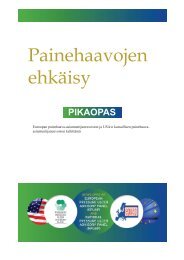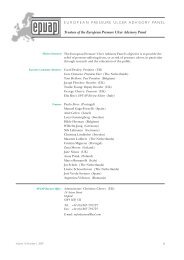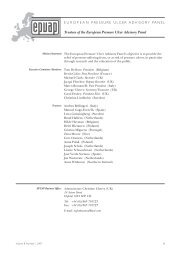SCALE Final Consensus Statement - European Pressure Ulcer ...
SCALE Final Consensus Statement - European Pressure Ulcer ...
SCALE Final Consensus Statement - European Pressure Ulcer ...
You also want an ePaper? Increase the reach of your titles
YUMPU automatically turns print PDFs into web optimized ePapers that Google loves.
decreased oxygen availability associated with the end<br />
of life. The plan of care needs to address excessive<br />
pressure, friction, shear, moisture, suboptimal<br />
nutrition, and immobilization.<br />
Prescription refers to the interventions for a treatable<br />
lesion. Even with the stress of dying, some lesions are<br />
healable after appropriate treatment. Interventions<br />
must be aimed at treating the cause and at patient<br />
centered concerns (pain, quality of life), before<br />
addressing the components of local wound care as<br />
consistent with the patient’s goals and wishes.<br />
Preservation refers to situations where the<br />
opportunity for wound healing or improvement is<br />
limited, so maintenance of the wound in its present<br />
clinical state is the desired outcome. A maintenance<br />
wound may have the potential to heal, but there<br />
may be other overriding medical factors that could<br />
direct the interprofessional team to maintain the<br />
status quo. For example there may be limited access<br />
to care, or the patient may simply refuse treatment.<br />
Palliation refers to those situations in which the<br />
goal of treatment is comfort and care, not healing.<br />
A palliative or non-healable wound may deteriorate<br />
due to a general decline in the health of the patient<br />
as part of the dying process, or due to hypoperfusion<br />
associated with non-correctable critical ischemia. 32,<br />
33<br />
In some situations, palliative wounds may also<br />
benefit from some treatment interventions such as<br />
surgical debridement or support surfaces, even when<br />
the goal is not to heal the wound. 34<br />
Preference includes taking into account the<br />
preferences of the patient and the patient’s circle of<br />
care.<br />
Table 2: Dermatological descriptions of lesions based on<br />
characteristics and size.<br />
Lesion<br />
Characteristics<br />
Lesion Size<br />
1 cm<br />
Flat Macule Patch<br />
Elevated Papule Plaque<br />
Blister Vesicle Bulla<br />
The 5P enabler can be used in combination with<br />
the SOAPIE mnemonic to help explain the process<br />
of translating this recommendation into practice<br />
(Figure 1). 35 Realistic outcomes can be derived from<br />
appropriate SOAPIE processes with the 5 skin Ps<br />
becoming the guide to the realistic outcomes for<br />
each individual.<br />
S = Subjective skin & wound assessment: The<br />
person at the end of life needs to be assessed by<br />
history, including an assessment of the risk for<br />
developing a skin change or pressure ulcer (Braden<br />
Scale or other valid and reliable risk assessment<br />
scale). 36<br />
O = Objective observation of skin & wound: A<br />
physical exam should identify and document skin<br />
changes that may be associated with the end of life<br />
or other etiologies including any existing pressure<br />
ulcers.<br />
A = Assess and document etiology: An assessment<br />
should then be made of the general condition of the<br />
patient and a care plan.<br />
P = Plan of care: A care plan should be developed<br />
that includes a decision on skin care considering<br />
the 5P’s as outlined in the Figure 1. This plan of<br />
care should also consider input and wishes from the<br />
patient and the patient’s circle of care.<br />
I = Implement appropriate plan of care: For<br />
successful implementation, the plan of care must<br />
be matched with the healthcare system resources<br />
(availability of equipment and personnel) along<br />
with appropriate education and feedback from the<br />
patient’s circle of care and as consistent with the<br />
patient’s goals and wishes.<br />
E = Evaluate and educate all stakeholders:<br />
The interprofessional team also needs to facilitate<br />
appropriate education, management, and periodic<br />
reevaluation of the care plan as the patient’s health<br />
status changes.<br />
<strong>SCALE</strong> <strong>Final</strong> <strong>Consensus</strong> <strong>Statement</strong>, October 1, 2009 Page 11
















